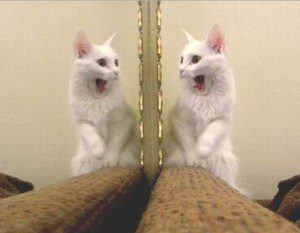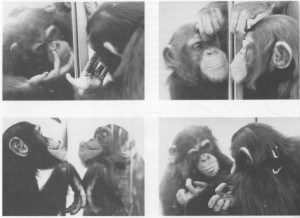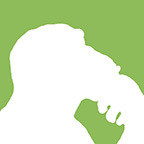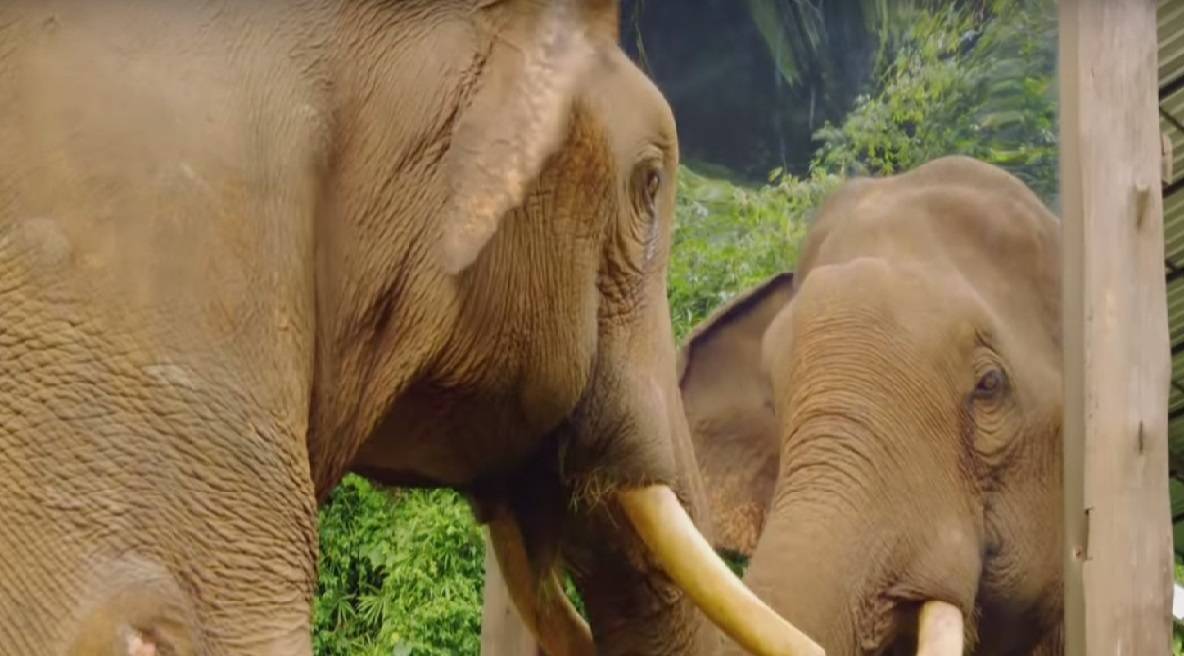The mirror test was developed by psychologist Gordon Gallup Jr.1 in 1970 as a method for determining whether a non-human animal has the ability of self-recognition. It’s also known as the “mark test” or “mirror self-recognition test” (MSR).
When conducting the mirror test, scientists place a visual marking on an animal’s body, usually with scentless paints, dyes, or stickers. They then observe what happens when the marked animal is placed in front of a mirror. The researchers compare the animal’s reaction to other times when the animal saw itself in the mirror without any markings on its body.
Animals that pass the mirror test will typically adjust their positions so that they can get a better look at the new mark on their body, and may even touch it or try to remove it. They usually pay much more attention to the part of their body that bears a new marking.
 Even if an animal doesn’t pass the test, they may still have interesting reactions to their reflections.
Even if an animal doesn’t pass the test, they may still have interesting reactions to their reflections.
Many species respond aggressively, or even show affectionate behavior. In such cases, it might be that the animal mistakes its reflection for another of its kind. This can lead to some amusing sights for human observers.
Humans are able to pass the mirror test when they are around 18 months old. But how do other animals fare?
Currently, 9 non-human animal species pass the mirror test. Not all individuals of each species pass, but many do. This list of animals that have passed the mirror test examines how each species responded during testing.
Asian Elephants
Asian elephants display a wide range of reactionary behaviors when they see their reflections in mirrors, and will respond to colored markings placed in-view on their bodies. However, not all of the elephants in a study2 by Joshua M. Plotnik passed. This might be because the normal behavior of elephants conflicts with what passing the mirror test requires. “
The mark test can be difficult to apply across species because it assumes that a particular animal will be interested in something weird on their body. Primates are interested in such things—we’re groomers. But elephants are different. They’re huge and they’re used to putting things on, not taking things off of their bodies, like mud and dirt.” said Plotnik.3
The Great Apes
Bo nobos, chimpanzees, orangutans, and gorillas have all passed the mirror test.4,1,5 However, it isn’t uncommon for many individuals to fail, especially if they are particularly young or old. In chimpanzees, there is evidence for self-recognition in about 75% of young adults.6 This percentage lowers with individuals closer to either end of the age spectrum.
nobos, chimpanzees, orangutans, and gorillas have all passed the mirror test.4,1,5 However, it isn’t uncommon for many individuals to fail, especially if they are particularly young or old. In chimpanzees, there is evidence for self-recognition in about 75% of young adults.6 This percentage lowers with individuals closer to either end of the age spectrum.
Many gorillas have failed the mirror test. When shown a mirror, a number of silverbacks have exhibited aggressive behavior. It has been speculated that most of the gorillas and other primates who do not pass the test may have inhibited behavior due to the presence of observing humans.
“Ironically, it may have been the gorillas’ very capacity for self-consciousness that prevented them from exhibiting behaviours indicative of self-recognition in the test situation.”7
Additionally, gorillas will often avoid eye contact with their reflection. By avoiding eye contact, gorillas are likely not able to look at their reflection long enough to realize that it is themselves who they are seeing. Koko the gorilla, well known for having learned sign language and performing well in other cognitive experiments, was the first of her species to pass the test.
Bottlenose Dolphins
Bottlenose dolphins usually show extreme interest when they catch sight of their reflections. They will open their mouths, stick out their tongues, and make a series of novel movements while observing themselves in the mirror. When marked, dolphins regularly inspect the marking.8
Orca Whales
In a study9, orca whales were allowed to view themselves in a mirror. Afterward, they were marked, then allowed to view themselves in the mirror once more. Their behavior showed that they expected the image would be altered as a result of their being marked – a strong indication that they understand the image in the mirror is indeed of themselves.
 Eurasian Magpies
Eurasian Magpies
The Eurasian magpie is the first non-mammalian species to pass the mirror test.10 When contrasting colored stickers were placed on their feathers, the magpies reacted to their reflections by trying to remove the mark. Birds who were marked with invisible stickers showed no altered behavior.
Prior to this experiment, scientists believed that self-recognition abilities came from the neocortex, a part of the brain found only in mammals. Since magpies are birds, they do not have this part of the brain. Magpies passing the mirror test shows that the ability of self-recognition can arise from different brain parts in other types of brains. It’s a case of “convergent evolution”. This happens when similar abilities, behaviors, and traits independently evolve in species that are not closel


